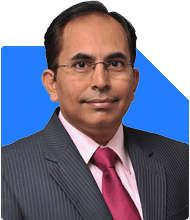Ramalingam Kalirajan |10893 Answers |Ask -Follow
Mutual Funds, Financial Planning Expert - Answered on May 30, 2024
He has an MBA in finance from the University of Madras and is a certified financial planner.
He is the director and chief financial planner at Holistic Investment, a Chennai-based firm that offers financial planning and wealth management advice.... more

I am invested in Axis Bluechip Fund, Parag Parikh Flexi Cap Fund, Canara Robeco Blue Chip Equity Fund & Canara Robeco Equity Hybrid Fund since Jan 21, need I change over to any other MF for better return or stay in the aboves, if yes for either of the two cases, then for how long?
Current Portfolio Overview
You have invested in four mutual funds since January 2021:
Axis Bluechip Fund
Parag Parikh Flexi Cap Fund
Canara Robeco Blue Chip Equity Fund
Canara Robeco Equity Hybrid Fund
These funds cover large-cap, flexi-cap, and hybrid categories, providing a balanced approach to your investments.
Evaluating Existing Funds
Axis Bluechip Fund: This is a large-cap fund known for stability and steady returns. It's a good choice for conservative investors seeking lower volatility.
Parag Parikh Flexi Cap Fund: This fund invests across market capitalisations and sectors, offering diversification. It's suitable for those seeking moderate to high growth with managed risk.
Canara Robeco Blue Chip Equity Fund: Another large-cap fund, providing similar benefits to Axis Bluechip. It adds stability to your portfolio.
Canara Robeco Equity Hybrid Fund: This fund invests in both equity and debt, offering a balanced approach with reduced risk. It's ideal for those seeking consistent returns with some exposure to equity growth.
Performance Review and Assessment
Review the performance of each fund over the last three years. Compare them to their benchmarks and peer funds. Consider their consistency, risk-adjusted returns, and performance during market volatility.
Making Informed Decisions
Continuing with High Performers
If your funds have shown consistent performance and align with your risk tolerance, continue with them. Long-term investments benefit from compounding, especially if the funds are performing well.
Switching Underperformers
If any fund consistently underperforms its benchmark or peers, consider switching to better-performing funds. Ensure the new funds align with your investment goals and risk profile.
Adding Sectoral and Thematic Funds
Consider adding sectoral or thematic funds for additional growth. These funds can offer higher returns but come with increased risk. Allocate a smaller portion of your portfolio to them.
Regular Review and Rebalancing
Periodic Review
Regularly review your portfolio's performance. This ensures your investments stay aligned with your financial goals and market conditions. Regular reviews help optimise returns and manage risks.
Rebalancing
Rebalancing your portfolio ensures it stays diversified and aligned with your risk tolerance. Adjust your investments based on performance and changes in your financial situation.
Advantages of Actively Managed Funds
Professional Management
Actively managed funds offer professional management, adapting to market changes. This flexibility can result in higher returns compared to passive index funds, which simply track the market.
Market Adaptability
These funds can adjust to economic shifts and opportunities, providing better performance during various market cycles.
Disadvantages of Index Funds
Lack of Flexibility
Index funds merely track market indices and may not perform well during market downturns. They lack the adaptability of actively managed funds, limiting potential returns.
Lower Potential Returns
Since they only aim to match the index, they may miss out on opportunities for higher returns that actively managed funds can capture.
Benefits of Investing Through a Certified Financial Planner
Tailored Advice
A Certified Financial Planner provides tailored advice and professional oversight. This ensures your portfolio aligns with your financial goals and risk tolerance.
Disadvantages of Direct Funds
Lack of Professional Guidance
Direct funds have lower expense ratios but lack professional guidance. Investing through a certified planner ensures informed decision-making and portfolio management.
Creating a Comprehensive Financial Plan
Consider other financial aspects like emergency funds, insurance, and tax planning. A holistic financial plan ensures a secure and well-rounded approach to wealth creation.
Monitoring Market Trends
Stay informed about market trends and economic factors. This knowledge helps you make timely adjustments to your investments, maximising returns and mitigating risks.
Conclusion
Your disciplined investment strategy and diversified portfolio are commendable. With regular review and professional guidance, you can optimise your investments and achieve your financial goals.
Best Regards,
K. Ramalingam, MBA, CFP,
Chief Financial Planner,
www.holisticinvestment.in
You may like to see similar questions and answers below
Omkeshwar Singh | Answer |Ask -Follow
Head, Rank MF - Answered on Jan 04, 2021
Omkeshwar Singh | Answer |Ask -Follow
Head, Rank MF - Answered on Nov 20, 2019
Ramalingam Kalirajan |10893 Answers |Ask -Follow
Mutual Funds, Financial Planning Expert - Answered on Apr 30, 2024
Ramalingam Kalirajan |10893 Answers |Ask -Follow
Mutual Funds, Financial Planning Expert - Answered on Mar 06, 2025
Janak Patel |71 Answers |Ask -Follow
MF, PF Expert - Answered on Mar 06, 2025
Ramalingam Kalirajan |10893 Answers |Ask -Follow
Mutual Funds, Financial Planning Expert - Answered on Apr 03, 2025
Ramalingam Kalirajan |10893 Answers |Ask -Follow
Mutual Funds, Financial Planning Expert - Answered on Dec 15, 2025
Ramalingam Kalirajan |10893 Answers |Ask -Follow
Mutual Funds, Financial Planning Expert - Answered on Dec 15, 2025
Radheshyam Zanwar |6746 Answers |Ask -Follow
MHT-CET, IIT-JEE, NEET-UG Expert - Answered on Dec 15, 2025
Ramalingam Kalirajan |10893 Answers |Ask -Follow
Mutual Funds, Financial Planning Expert - Answered on Dec 15, 2025
Ramalingam Kalirajan |10893 Answers |Ask -Follow
Mutual Funds, Financial Planning Expert - Answered on Dec 15, 2025
Ramalingam Kalirajan |10893 Answers |Ask -Follow
Mutual Funds, Financial Planning Expert - Answered on Dec 15, 2025
Samraat Jadhav |2508 Answers |Ask -Follow
Stock Market Expert - Answered on Dec 15, 2025
Ramalingam Kalirajan |10893 Answers |Ask -Follow
Mutual Funds, Financial Planning Expert - Answered on Dec 15, 2025
Reetika Sharma |425 Answers |Ask -Follow
Financial Planner, MF and Insurance Expert - Answered on Dec 15, 2025
Radheshyam Zanwar |6746 Answers |Ask -Follow
MHT-CET, IIT-JEE, NEET-UG Expert - Answered on Dec 15, 2025


























